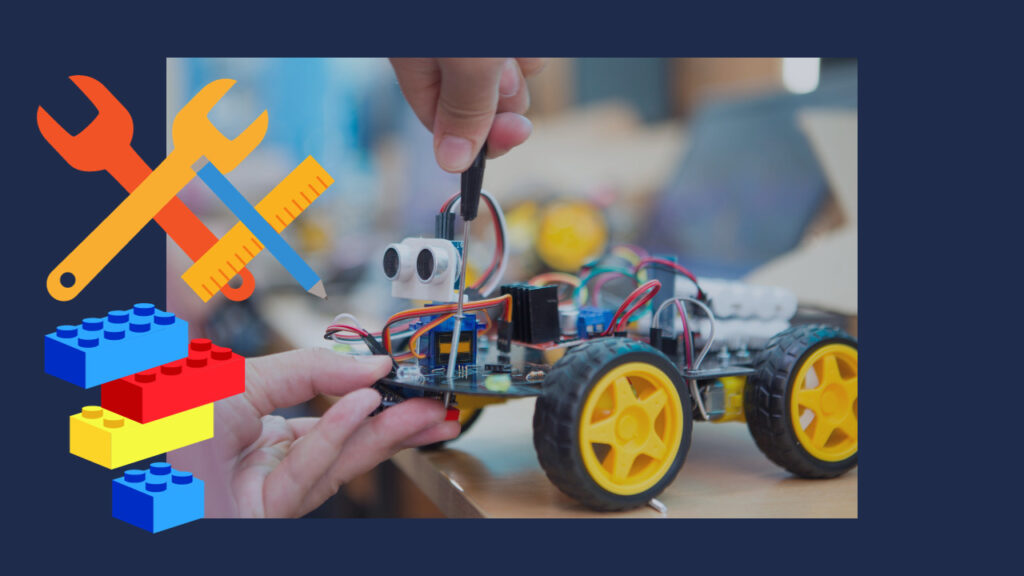Challenge yourself with a game
Innovation has always been the driving force behind human progress. It’s the catalyst that propels us into new frontiers, challenging the status quo and reshaping the world as we know it. Today, we find ourselves on the cusp of a technological revolution that promises to transform every aspect of our lives. However, this transformative power often comes with a shadow of fear and uncertainty. In this article, we will explore how innovation is on the verge of taking us into uncharted territories and how we can confront and overcome the fear of technology.
In a world dominated by technology, it’s not uncommon for individuals to feel afraid of what the future would look like in terms of work, life, and finances connected with technology. I very good idea is to start comprehending technology as learning something new: something is supposed to be funny.
For those who have been dreaming of creating their own innovations. For some, it’s the thrill of bringing imagination to life. One such exciting and creative endeavor is the journey of exploring technology and creating a robot. We’ll embark on a journey of discovery and innovation, tracing the steps from an idea to a functional robot.
The Spark of Inspiration
One of the fundamental reasons behind our fear of technology is the fear of the unknown. As innovation accelerates, the pace of change can be overwhelming. New technologies, such as artificial intelligence, quantum computing, and biotechnology, are emerging at an unprecedented rate. While these advancements hold immense potential, they also raise questions about their impact on employment, privacy, and ethics.
Facing the fear of the unknown requires a shift in perspective. Instead of viewing technology as a threat, we can choose to see it as an opportunity for growth and improvement. By embracing a mindset of curiosity and adaptability, we can harness the power of innovation to address the challenges of the future.
Every great project begins with a spark of inspiration. In the realm of robotics, this spark can come from a variety of sources – from science fiction movies to real-world problems that beg for a technological solution. The key is to find something that excites and motivates you. Perhaps you’ve always wanted to build a robot that could help with household chores or one that can explore hazardous environments. Your inspiration could come from a desire to learn, a need to solve a problem, or simply a fascination with robotics.
Why I’m talking about Robotics?
One way to confront the fear of technology is through education and awareness. As individuals, we can take the initiative to stay informed about the latest technological developments and their implications. Understanding how technology works and its potential benefits can demystify the fear associated with it and the easiest ways is: playing with building a robot!
A robot is an electromechanical device programmed to make decisions and act without manual intervention. From professional and service robots to domestic robots, there is a wide range of devices available. With access to robotic kits and advice from robotic experts, it makes sense that more people are wondering how to build their own robots.
For example, Robotix, the renowned U.S.-based educational company, has introduced the CV Pro, an easy-to-connect and easy-to-use robot. The best part is that it comes with open source technology, allowing both experimenting and learning about artificial intelligence and the potential of autonomous vehicle technology.
The company emphasizes hands-on, playful learning, allowing children to experiment with electronics and robotics. The robotics and STEM kits promote science education in an entertaining way, preparing young people for an ever-evolving future job market.
Aside from opening a world of opportunity, dabbling in basic robotics also expands your skill set. Is like playing with legos. It lets you improve critical and creative thinking, and paired with the right mindset, provides hours of fun. Even a basic robot for kids can be exciting as the robotic field is designed to challenge the mind.
Once you’ve found your inspiration, it’s time to start learning the basics. Robotics is a multidisciplinary field that combines elements of computer science, electronics, mechanics, and more. Depending on your background, you might need to start from scratch or build on existing knowledge. Online courses, textbooks, and communities of fellow enthusiasts are valuable resources for gaining the necessary skills and knowledge.
With advances in autonomous driving technology, new applications will emerge in various sectors. He mentioned examples such as robot cabs, farm vehicles, mining vehicles and many others, reiterating that the possibilities are endless. If you don’t have previous robot-building experience but want to learn the basics of how to build your own robot from scratch, start with a simple robot.
Wenn das Fundament steht, ist es an der Zeit, deinen Roboter zu entwerfen. In dieser Phase verwandelst Du Deine Inspiration in ein greifbares Konzept. Du musst Dich für den Zweck, die Größe, die Form und die Fähigkeiten des Roboters entscheiden. Skizzen, Entwürfe und CAD-Software helfen Dir, Deinen Entwurf zu verfeinern.
In der Robotik kann die Bauzeit sehr unterschiedlich sein. Der Bau von komplexen Robotern kann mehrere Jahre dauern, während ein einfacher Roboter in ein paar Stunden gebaut werden kann. Das hängt auch davon ab, wie viel Erfahrung Du im Programmieren oder in der mechanischen und elektrischen Montage hast.
Let’s see simple steps to Design Your Robot
With a foundation in place, it’s time to start designing your robot. This phase is where you take your inspiration and turn it into a tangible concept. You’ll need to decide on the robot’s purpose, size, shape, and capabilities. Sketching out your ideas, creating rough drafts, and using CAD software can help you refine your design.
In robotics, build time can widely vary. Complex robots can take several years to build, while a simple one can be built in a couple of hours. It also depends on your level of programming experience or mechanical and electrical assembly expertise.
Selecting Components
The heart of any robot lies in its components. You’ll need to choose the right hardware and software to bring your robot to life. This includes microcontrollers, sensors, motors, and actuators. Careful research and consideration are crucial to ensure compatibility and efficiency.
The cost of making your own custom robot heavily depends on its complexity. Basic DIY Robots with basic building pieces can have a total cost ranging from $40 to hundreds of dollars. Bigger ones, like professional, service, or industrial robots, can cost up to a hundred thousand dollars.
Building a robot requires a varying number of components and versatile pieces. Building an electromechanical device may require an instruction booklet, but you don’t have to be an electrical engineer to build one. To make things easier for you, we’ve listed components and tools you will need to make your DIY robot.
Actuators and Sensors:
There are different types of sensors that help the robot receive input from the outside world. For example, a distance sensor acts as the eyes and helps the robot discern data about how far something is. Actuators are the “muscles” of the robot that use this data to react and move appropriately.
The Processing Unit:
The microcontroller is the processing unit, also referred to as the brain of the robot. It handles data from the sensors and gives commands to the rest of the robot to react appropriately. An Arduino microcontroller or a Raspberry Pi are two of the most common controllers for simple DIY robots.
Batteries:
If the processing unit is the brain, the battery is the heart. Your battery should have enough energy to power up all the components like the sensors, actuators, and microcontrollers. A rechargeable battery is better than a disposable one. The disposable battery costs more over time and uses up natural minerals.
Robot Chassis:
The robot chassis is where you mount all the parts; it is the body of the robot. You can either buy a chassis for your robot or custom make one. The robot chassis should be durable enough to handle its weight, and spacious enough to accommodate the parts.
Mechanical and Electrical Tools:
In the whole process of assembling components, you will need various tools. At the very least, you will need screwdrivers, pliers, and a breadboard for prototyping. The other tools you need will depend on the components you choose for your robot.
Programming Your Robot
Once you’ve thought about the purpose and design of your robot, you must choose your processor and brain. An Arduino or Raspberry Pi is usually enough to cover simple robot processes but feel free to explore other options. Choose a microcontroller or microprocessor best suited to your goals and what you want your robot to achieve.
Think about whether your robot needs a color sensor, a distance sensor, or an infrared sensor. Perhaps it needs all three or something entirely different? Ensure you get the appropriate sensors, motors, and power source ready for your robot.
Do the necessary wiring to connect the processor, sensors, and actuators. Simple robots, at this level, usually only use simple DC motors, servo motors, or stepper motors. Any processor you use should have no problem managing these actuators and connecting them to sensors.
Now that all the robot parts are connected, it’s time to plug your microcontroller into your computer. Install the needed software for your microcontroller, such as an Arduino IDE if you’ve used an Arduino board. There are usually detailed instructions on your microcontroller website for this step.
Do You Need Coding Skills to Create a Robot?
Yes, you need coding skills to create a robot. To create even a simple robot, you’ll need to have a basic understanding of coding, but you don’t have to be a pro. Technically, you could copy and paste code from the Internet, but those aren’t always compatible with the robot parts you assemble, In this wiki how and in several spaces in the web you can find open source code that you can install in your robot, so at least you can have a based.
Programming is the brain behind your robot’s operations. Depending on your robot’s complexity, you may need to learn programming languages like C++, Python, or even specialized robot programming languages. Writing code for controlling movement, processing sensor data, and making decisions is a fundamental aspect of creating a functional robot.
Assembling and Testing
If everything is functioning properly, carefully mount it all up on your chassis. You can usually buy a good robot chassis for a reasonable price, but you can also build one yourself. If you purchased a robot-building kit, it should come with a chassis.
With all your components and code ready, it’s time to assemble your robot. This phase can be both exciting and challenging, as you’ll need to connect everything together, troubleshoot issues, and refine your design. Don’t be discouraged by setbacks; problem-solving is an integral part of the process.
Iterating and Improving
Once your robot is up and running, the journey is far from over. Real-world testing often reveals areas that need improvement. This iterative process of refining your robot, enhancing its capabilities, and addressing any shortcomings is what makes a great robot even better.
Final thoughts
Adaptation is another key aspect of confronting the fear of technology. As technology evolves, so must our skills and mindset. Lifelong learning and adaptability will be essential in a future where the only constant is change.
Innovation is an unstoppable force that will continue to shape our world. Rather than succumbing to fear and resistance, we have the choice to embrace technology with curiosity, responsibility, and a commitment to ethical principles. By educating ourselves, fostering collaboration, and staying adaptable, we can not only confront the fear of technology but also harness its potential to create a better future for all. As we venture into uncharted territory, let us remember that innovation, when guided by our values and aspirations, has the power to transform the world for the better.
While innovation offers boundless opportunities, it also poses ethical challenges that cannot be ignored. Concerns about privacy, data security, and the responsible use of technology are valid and require careful consideration. However, addressing these concerns does not necessitate avoiding technology altogether. Instead, it calls for responsible innovation and ethical frameworks that guide the development and deployment of new technologies.
Creating a robot is a rewarding and educational journey that combines creativity, technology, and problem-solving. From the initial spark of inspiration to the final, functional robot, each step is an opportunity to learn and grow. Whether you’re a hobbyist or aspiring engineer, exploring technology through robot creation offers a unique and fulfilling experience. So, embrace your curiosity, gather your resources, and embark on your own journey of innovation and discovery in the world of robotics. Who knows what amazing creations you’ll bring to life?












